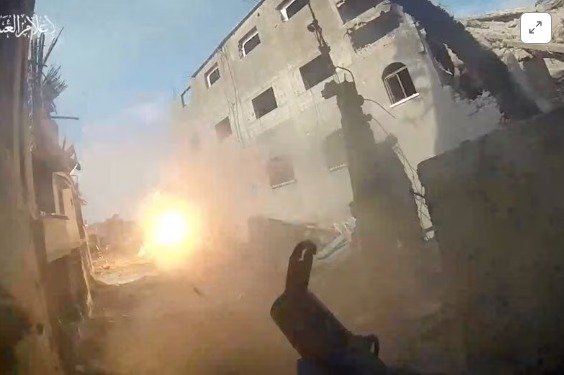Dec. 15: The Israeli army’s death toll in Gaza is already almost twice as high as during a ground offensive in 2014, a reflection of how far it has pushed into the enclave and of Hamas’ effective use of guerrilla tactics and an expanded arsenal, Reuters reported on Friday.
According to the Reuters report by Dan Williams, Nidal al-Mughrabi and Jonathan Saul, Israeli military experts, an Israeli commander and a Hamas source described how the Palestinian group has used a big weapons stockpile, its knowledge of the terrain and a vast tunnel network to turn Gaza’s streets into a deadly maze.
At their disposal, they have arms ranging from drones rigged with grenades to anti-tank weapons with powerful twin charges, the report claimed.
Since Israel’s ground campaign began in late October, about 110 Israeli soldiers have been killed as tanks and infantry thrust into the cities and refugee camps, based on official Israeli figures. About a quarter were tank crew, the report added.
That compares with 66 in the 2014 conflict, when Israel launched a more limited three-week ground incursion but the goal then was not to eliminate Hamas.
“There is no comparing the scope of this war to 2014, when our forces mostly operated no deeper than a kilometre inside Gaza,” said Yaacov Amidror, a retired Israeli major-general and former national security adviser who is now at the Jewish Institute for National Security of America (JINSA).
He said the army “has yet to find a good solution for the tunnels,” a network hugely expanded in the past decade.
Since the war began, more than 18,000 people have been killed in Gaza, sparking international demands for a ceasefire and even calls from Israel’s staunch ally the United States for a shift in strategy and more precise strikes.
Prime Minister Benjamin Netanyahu said on Thursday Israel would wage war “until absolute victory”. Israeli officials have said it could take months before being complete.
“It has been a challenge from day one,” Ophir Falk, foreign policy adviser to Netanyahu, told Reuters, saying the offensive had come with a “huge price” in Israeli soldiers.
“We know that we’re going to probably have to pay an additional price to complete the mission.”
Heavy Fighting
Hamas has posted videos on its Telegram channel this month showing fighters with bodycams weaving through buildings to launch shoulder-held rockets at armoured vehicles. One of them, posted on Dec. 7, was from Shejaiya, east of Gaza City, an area where both sides reported heavy fighting.
In another post on Dec. 5, a camera emerges from a tunnel, like a periscope, to scan an Israeli camp where soldiers rested. The post said it was later hit by an underground blast. The Reuters report claimed the agency could not verify the videos.
A Hamas source, who spoke to Reuters from inside Gaza on condition of anonymity, said fighters moved as close as possible to launch ambushes “taking advantage of the land we know like no others do”, often moving around or emerging from tunnels.
“There is a huge discrepancy between our power and their power, we don’t fool ourselves,” he said.
Hamas has not said how many of its fighters have been killed. Israel’s military has said it has killed at least 7,000. The group has previously dismissed the Israeli figure, saying it includes civilians.
An Israeli commander, who fought in 2014, said the expanded scope of this operation meant more troops were on the ground, giving Hamas the “defender’s advantages”, so higher troop casualties were to be expected. He asked not to be named because he is an active reservist in this war, the report added.
Israel’s military does not release numbers of troops involved or other operational details.
Israel’s Channel 12 television showed one army reservist unit, wary of booby-trapped doors, smashing through the wall of a building to enter a room to discover a munitions cache.
Mirroring tactics used in 2014, Israel’s military has posted images on social media showing routes smashed through built-up areas by bulldozers so troops can avoid existing roads that might have landmines.
Even in some districts in north Gaza where many buildings have been pounded into rubble, bouts of fierce fighting have persisted.
Building Up Forces
“Hamas made some huge steps to build up its force since 2014,” said Eyal Pinko, a former senior official with Israel’s intelligence services who is now at Bar Ilan University’s Begin-Sadat Center for Strategic Studies.
He reportedly alleged some advanced arms, such as Russian-designed Kornet anti-tank missiles, were smuggled in with the help of Hamas’ ally Iran. But he said Hamas had mastered building other weapons in Gaza, such as RPG-7 rocket-propelled grenades, and the fighters now had a bigger munitions reserve.
Hamas posts have said the group’s weaponry includes “tandem” anti-tank weapons with two charges to pierce armour, which Pinko also said was in their arsenal.
Hamas videos often show big blasts when vehicles are hit. Israeli military experts said a blast did not mean a vehicle was destroyed as they said it could also be caused by defensive systems that exploded to halt incoming projectiles.
Ashraf Abouelhoul, the managing editor of Egypt’s Al-Ahram daily who previously worked in Gaza and is a specialist on Palestinian affairs, said militants were moved as close as possible to launch missiles and “locally-made projectiles”.
But he said Israeli drones and other tactics were eroding their ability to surprise, even in urban areas.
“Hamas may post their new weapons and tactics, (but) in principle, it remains a guerrilla resistance movement,” said Alexander Grinberg, a former Israeli military intelligence officer with the Jerusalem Institute for Strategy and Security, the report mentioned.




